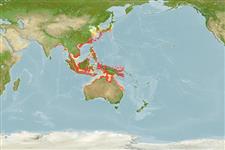Teleostei (teleosts) >
Callionymiformes (Dragonets) >
Callionymidae (Dragonets)
Etymology: Callionymus: Greek, kallion, comparative of kallos = beautiful + Greek, onyma = name; with a better name.
More on author: Pallas.
Environment: milieu / climate zone / depth range / distribution range
Ecology
Marine; brackish; demersal. Tropical; 41°N - 26°S, 84°E - 154°E
Indo-West Pacific: Arabian Peninsula to the Philippines. Occurs in the Mekong delta of Viet Nam and probably also in Cambodia.
Size / Weight / Age
Maturity: Lm ? range ? - ? cm
Max length : 11.0 cm TL male/unsexed; (Ref. 12693)
Dorsal spines (total): 4; Dorsal soft rays (total): 9; Anal soft rays: 9. Head and body sand yellow, covered with numerous small dark spots. Ventral sides whitish. Dorsal fin black, first membrane often (at least basally) whitish in females. Anal fin white. Second dorsal, caudal, pectoral, and pelvic fins spotted with brown (Ref 42832).
Occur on the bottom along coastlines and in estuaries and the lower courses of rivers. Feed on worms, zooplankton, and phytoplankton. Not seen in the markets (Ref. 12693).
Life cycle and mating behavior
Maturity | Reproduction | Spawning | Eggs | Fecundity | Larvae
Rainboth, W.J., 1996. Fishes of the Cambodian Mekong. FAO species identification field guide for fishery purposes. FAO, Rome, 265 p. (Ref. 12693)
IUCN Red List Status (Ref. 130435: Version 2024-2)
Threat to humans
Harmless
Human uses
Fisheries: of no interest
Tools
Special reports
Download XML
Internet sources
Estimates based on models
Preferred temperature (Ref.
123201): 23.3 - 29.1, mean 28.3 °C (based on 1276 cells).
Phylogenetic diversity index (Ref.
82804): PD
50 = 0.5000 [Uniqueness, from 0.5 = low to 2.0 = high].
Bayesian length-weight: a=0.00891 (0.00410 - 0.01937), b=2.78 (2.60 - 2.96), in cm total length, based on LWR estimates for this Genus-body shape (Ref.
93245).
Trophic level (Ref.
69278): 2.9 ±0.29 se; based on food items.
Resilience (Ref.
120179): High, minimum population doubling time less than 15 months (Preliminary K or Fecundity.).
Fishing Vulnerability (Ref.
59153): Low vulnerability (10 of 100).
